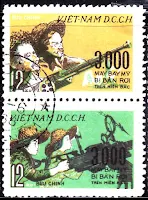Myriad philatelic content from around the world, such as first day covers, block stamp sets, maxicards, may be found at this website.
Friday, June 30, 2023
Wednesday, June 28, 2023
Poste Francaises (Vichy) Victims of Allied Bombings
North Vietnam Propaganda Victory Stamps
- TAY NGUYEN Bat Khuat (Battle of Ban Me Thuot)
- TRỊ THIÊN Quat Khoi (First Battle of Quảng Trị)
- CU-CHI Dat Thep (Cu Chi Tunnels)
North Vietnam Propaganda Stamps of American Aircraft Downed
Deutsches Reich Weimar Verfassunggebende Deutsche Nationalversammlung - 1919
The Weimar National Assembly (German: Weimarer Nationalversammlung), officially the German National Constitutional Assembly (Verfassunggebende Deutsche Nationalversammlung), was the popularly elected constitutional convention and de facto parliament of Germany from 6 February 1919 to 21 May 1920. As part of its duties as the interim government, it debated and reluctantly approved the Treaty of Versailles that codified the peace terms between Germany and the victorious Allies of World War I. The Assembly drew up and approved the Weimar Constitution that was in force from 1919 to 1933 (and technically until the end of Nazi rule in 1945). With its work completed, the National Assembly was dissolved on 21 May 1920. Following the election of 6 June 1920, the new Reichstag met for the first time on 24 June 1920, taking the place of the Assembly.
Source: Wikipedia
Deutsches Reich (Weimar) Defintives of Famous Germans - 1926 & 1927
The designs feature:
- 3 Pf., 25 Pf. - Johann Wolfgang von Goethe (1749-1832)
- 5 Pf. - Friedrich von Schiller (1759-1805)
- 8 Pf., 20 Pf. - Ludwig von Beethoven (1770-1827)
- 10 Pf. - Frederick the Great (1712-1786)
- 15 Pf. - Immanuel Kant (1724-1804)
- 30 Pf. - Gotthold E. Lessing (1729-1781)
- 40 Pf. - Gottfried Wilhelm Leibniz (1646-1716)
- 50 Pf. - Johann Sebastian Bach (1685-1750)
- 80 Pf. - Albrecht Durer (1471-1528)
All of these Weimar Republic definitive postage stamps were issued both in panes of 100 and in coil rolls. The 5 Pf., 8 Pf., 10 Pf., and 15 Pf. denominations were also issued in booklets, having panes of 10 stamps for each denomination. A very rare variety of the 20 Pf. is known with a sideways watermark.
Source: Stamp Collecting . com
Sunday, June 25, 2023
South Vietnam Trung Trac & Trung Nhi - 1959
These two high-born Vietnamese sisters rallied their people in order to fight against oppression. Known simply as the Trung sisters, Trung Trac and Trung Nhi raised an army and went to battle in order to protect their ancestral homeland. China had occupied Vietnam for half a century when the oppressive rule of Governor To Dinh provoked a rebellion by Vietnamese nationalists.
When Trung Trac's husband was executed for plotting against the Han Chinese, Trung Trac and her sister Trung Nhi led other Vietnamese nobles with a small army as, in 39 A.D. Armed with swords, bows and arrows, axes and spears, these elephant-riding warrior sisters and their army stormed 65 Chinese-run citadels and the governor’s home, successfully forcing the Chinese leader out of the region. They seized control of an area extending from Hue to southern China and ruled for two years.
When the Han Chinese first invaded the area now known as Vietnam in 111 BC, they immediately installed several local rulers to act as conduits for Chinese interests. Among those local leaders was the Trung sisters’ father—who, like several of the other installed rulers, did manage to push back against the Chinese on occasion in order to protect the interests of the local people.
Southeast Asian society at the time was quite progressive when it came to women’s rights, especially when regarding educational access and property ownership. “It was a society where women had a lot of rights,” says Keith Taylor, a professor of Sino-Vietnamese cultural studies at Cornell University. “From what we can tell from society at that time, women did have a very high status. People inherited property, and their social position, and a lot of other rights through their mothers and their fathers.”
In 42 A.D. they were defeated by a much larger Chinese army near modern Hanoi.To avoid capture, the sisters drowned themselves in the Red River (Song Hong).
In the 2,000 years since their deaths, the legend of the Trung sisters has come to represent Vietnamese nationalism—and a rare moment in which two young women ruled an independent nation pushing back against colonial repression. They became symbols of freedom, immortalised in plays and folktales, as well as worshiped by cults. Hai Ba Trung Day is a Vietnamese national holiday.
Source: A&E History
Monday, June 12, 2023
New Zealand Health "Hygieia" - 1932
Saturday, June 10, 2023
Deutsche Bundespost Welfare Stamps of German-speaking Actors
Thees Bond villains: Gert Fröbe as the legendary Mister Goldfinger and Curd Jürgens as the villain Stromberg in "The Spy Who Loves Me"; the two ladies: Lilli Palmer and the unfo stamps were dedicated to two Jamrgettable Romy Schneider - better known as Sissi; and last but not least, perhaps the greatest of all - Heinz Rührmann.
The designer was Antonia Graschberger. Bundesdruckerei printed over 4 million multicolour stamps of each set, measuring 46.5 x 28 mm with 14 perforations, using an offset lithography method on fluorescent paper. The First Day Cover cancellations originated from Bonn, Germany.Thursday, June 8, 2023
Vietnam 30th Anniversay of the Battle of Dien Bien Phu
The Battle of Dien Bien Phu was the climactic confrontation in the First Indochina War between the French Union's French Far East Expeditionary Corps and Viet Minh communist-nationalist revolutionaries. It was, from the French view before the event, a set piece battle to draw out the Vietnamese and destroy them with superior firepower. The battle occurred between March and May 1954 and culminated in a comprehensive French defeat that influenced negotiations over the future of Indochina at Geneva.
North Vietnam Propaganda Stamp of US Pilot and Vietnamese Soldier
North Vietnam American Anti-war Activist Norman Morrison
Norman Morrison was a devout Quaker and anti-war activist best known for his act of self-immolation at age 31 to protest United States involvement in the Vietnam War. On 2 November 1965, Morrison doused himself in kerosene and set himself on fire below the office of Secretary of Defense Robert McNamara at the Pentagon.
It has been suggested his action may have been taken after Thích Quảng Đức and other Buddhist monks, who burned themselves to death to protest the repression committed by the South Vietnam government of Catholic President Ngo Dinh Diem.
Morrison’s choice to self-immolate was particularly symbolic in that it followed President Johnson’s controversial decision to authorise the use of napalm in Vietnam, a burning gel that sticks to the skin and melts the flesh.
Morrison was perceived to be sane and sincere in sacrificing himself for a cause greater than himself. In North Vietnam, Morrison quickly became a folk hero to some, his name rendered as Mo Ri Xon. Five days after Morrison died, Vietnamese poet Tố Hữu wrote a poem, "Emily, My Child", assuming the voice of Morrison addressing his daughter Emily and telling her the reasons for his sacrifice.
Morrison's widow, Anne, and the couple's two daughters visited Vietnam in 1999, where they met with Tố Hữu, the poet who had written the popular poem Emily, My Child.
On his visit to the United States in 2007, President of Vietnam Nguyễn Minh Triết visited a site on the Potomac near the place where Morrison immolated himself and read the poem by Tố Hữu to commemorate Morrison.
Today, there are streets in the Vietnamese cities of Da Nang and Hanoi named after Norman Morrison in memory of his act against American involvement in South Vietnam.
Source: Wikipedia























